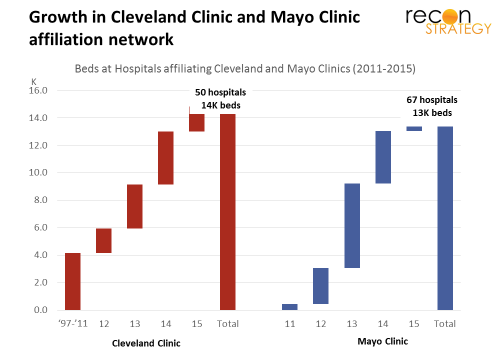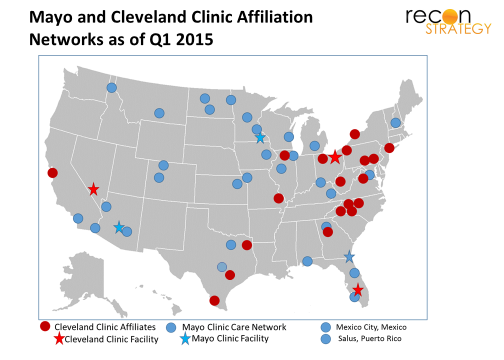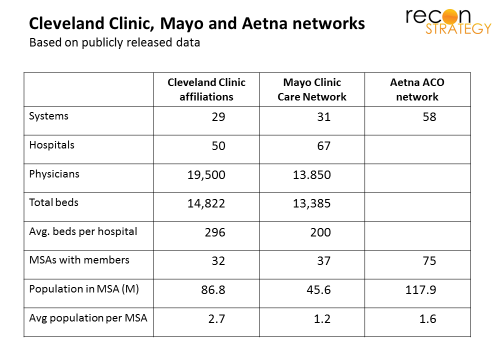The build-out of the Cleveland Clinic and Mayo branded networks continues apace. Most recently, the Virginia Hospital Center joined the Mayo Clinic Care Network in March and Sequoia Hospital (Dignity), Piedmont Healthcare and Valley Health System (NJ) signed up with Cleveland Clinic this past March and early April.
Growth of the networks and current snapshot
These four deals cap torrid growth in the networks especially in 2013 and 2014. As of the end of the first quarter of 2015, Mayo has affiliations with systems totaling 13.4K beds (and a rough estimate of 14K employed physicians) while the Cleveland clinic network has nearly 14K beds (in systems with a roughly an equal number of employed physicians).
These affiliation networks are achieving some real geographic reach with Cleveland Clinic focused on the Mid-Atlantic and Mayo more in the Midwest and Southwest:
Notably, the emerging Cleveland Clinic network is starting to rival Aetna’s ACO partner network in terms of population covered (at an MSA level):
Key elements of the network relationship
While the Cleveland Clinic and Mayo networks are often compared in the press, they are actually quite different in scope and structure and – in our view – strategic impact:
Mayo Clinic Care Network
- Light footprint one-way expertise provision
- Standardized template of collaboration focused on physician-to-physician second opinions (“eConsults”) and access to protocols, guidelines and references (“AskMayoExpert”); no patient-to-physician referrals or broader research collaborations (unless these are part of some separate but parallel Mayo-member collaboration)
- Typical members have smaller hospitals and are located in more rural settings vs. Cleveland Clinic (especially given all those sites in the upper Midwest and Rockies – see exhibit above).
Cleveland Clinic affiliations
- Affiliations typically with a specific Clinic Institute for a specific domain of care. Out of the 29 affiliations in place, most are cardiac related (e.g., with the Heart and Vascular Institute or for Heart Surgery), 3 are part of the National Orthopedic and Spine Alliance, 2 are with the Clinical and Research Alliance and 1 each for Neurology, Transplant and Bariatric Surgery.
- The scope of the affiliations can vary from
- best practice, protocol sharing, second opinions (similar to Mayo), to
- quality assurance programs, continuing medical education, data analytics and benchmarking, to
- much larger collaboration on research programs, cross-staffing, and referrals. One variation – the Cleveland Clinic Cardiovascular Specialty Network – involves exclusive partnerships for cardiac referrals through Cleveland Clinic’s direct bundled payment contracts with employers in the member’s geographic area
- Typical members have larger hospitals than Mayo and are located in denser population concentrations — not surprising given the affiliations each cover for highly sophisticated care in specific medical domains.
Strategic implications
Broadly, Mayo’s network seems more focused on influencing care quality beyond Mayo’s service areas and securing an easy, profitable revenue stream. However, this “expertise access” is an unlikely platform for a deeper strategic relationship between Mayo and the members. Nor is it likely to substantially enhance Mayo’s strategic advantages (e.g., materially adding to its data pools). From a strategic perspective, Mayo has perhaps obtained an option via these deals to deepen the relationship in the future (a least a right of first offer if Cleveland Clinic were to start wooing any one of the system).
Cleveland Clinic’s relationships are no doubt a lot more costly to build and service (and these investments can be lost as when Northwestern combined with Cadence in Chicago in 2014, putting Cleveland Clinic’s 4 year relationship with Cadence at risk). But, on the whole, the network has much greater potential to provide Cleveland Clinic with strategic benefit especially around patient volume from some members (Cleveland Clinic physicians treating locally, formalized referral pathways from partners to Cleveland Clinic for more serious cases) and research scale (data, trial recruitment, etc.)
So, why is Mayo comfortable keeping its network so “light” in the era of big data? Probably because it has at least two other major ways to secure the data scale:
- Its OptumLabs research joint venture with UnitedHealth which allows access to the vast data warehouses and analytical horsepower of Optum. Note: this JV has itself been rapidly expanding its partnership network both academically and in the life sciences.
- Its High Value Healthcare Collaborative (HVHC) network which brings together 17 high performing systems to research the most clinically and economically effective care protocols together.
This comfort may not last long, however: the Cleveland Clinic and Mayo networks are getting big enough to start bumping into each other (e.g. Chicago, Dallas, Atlanta, DC) and local systems will be compelled to choose among the rivals. In the opening skirmishes of this emerging battle, Cleveland Clinic has, it seems, the advantage: Two prominent members of the HVHC – Baylor Scott and White (2014) and North Shore LIJ (2012) – have signed deals to be part of Cleveland Clinic’s exclusive Cardiovascular Specialty Network. For the time being, they also both members of the HVHC – but how long can they continue to dance with rivals before needing to make a choice?
The Mayo Clinic Care Network membership may be even more vulnerable (after all, the value proposition for participation is lower than the HVHC). Mayo may find itself forced to bulk up the depth of the Care Network relationship to make it a more credible counter to a Cleveland Clinic affiliation – or see these relationships hollowed out as individual medical domains in each network member — Cardiac, Orthopedic, Neurology and Transplant domains – slip away and link with Cleveland.



